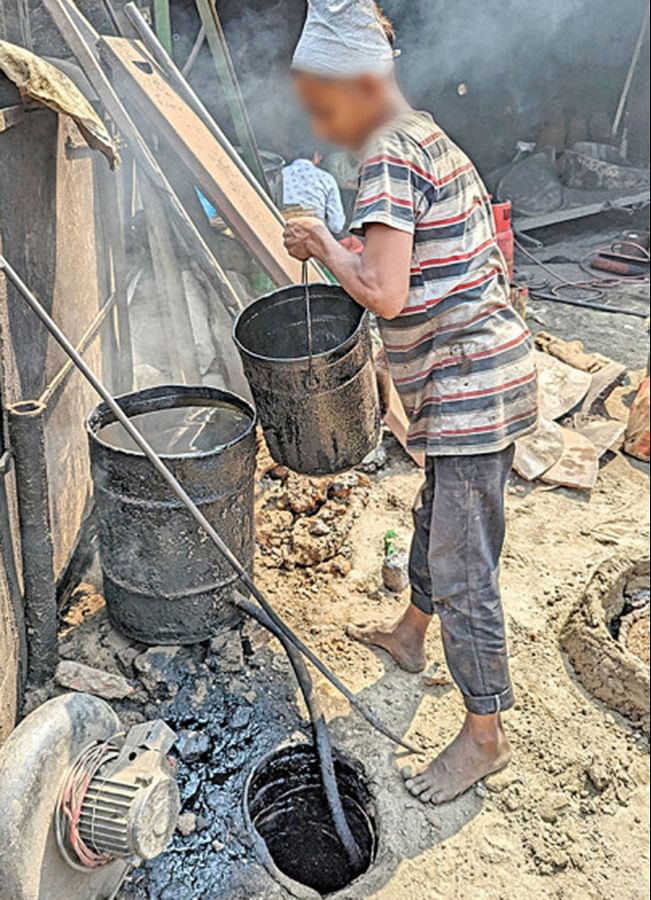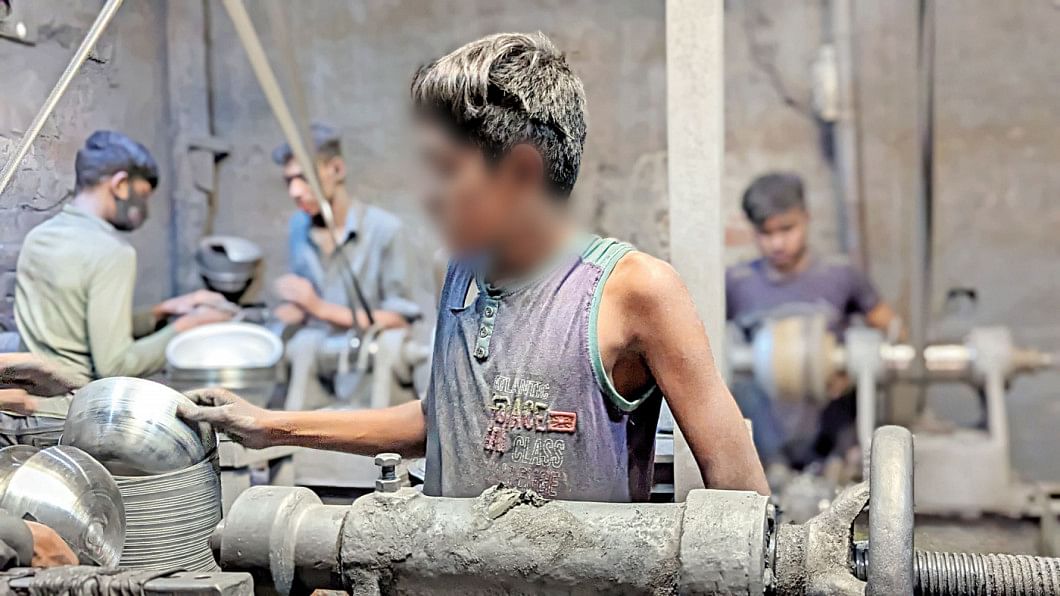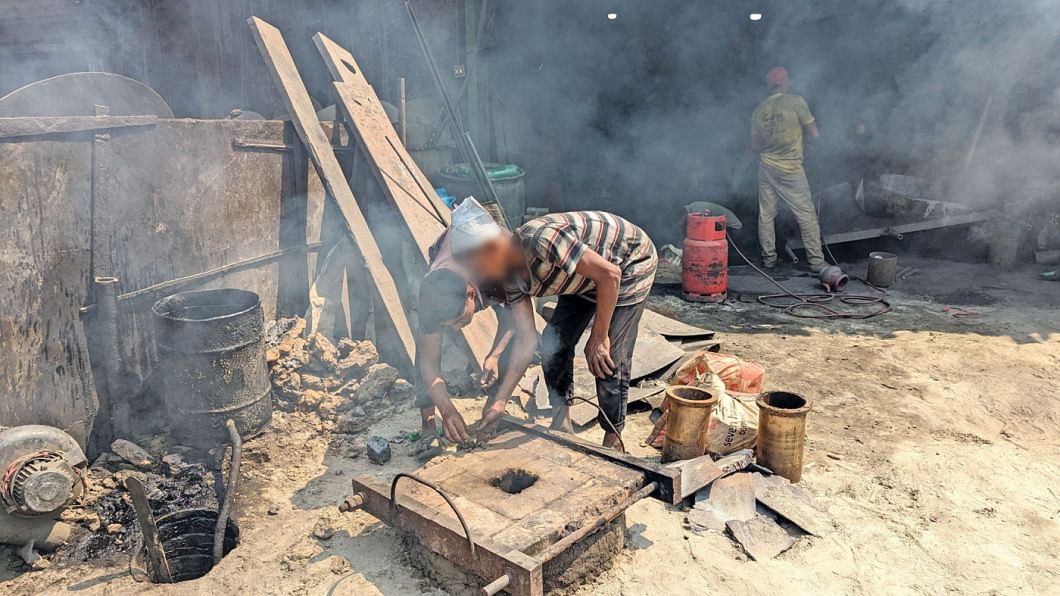Toiling away childhood
At a time when he should have been going to school and growing up with all the happiness and blessings life has to offer, Sajjad ended up experiencing the other end of the spectrum.
At merely 10 years of age, after studying till fourth grade, he was compelled to leave school and start working at a dockyard due to financial strains faced by his family. Over the course of the next four years, all that was left of his childhood was lost amid gigantic metal structures of ship parts, excruciating heat radiating from massive furnaces, and toxic fumes wafting from the fuel oil burning inside those.
Sajjad, now 14, is not an isolated case, rather he embodies the plight of hundreds of other children like him toiling at the dockyards located along the banks of Buriganga.
Action for Social Development in a 2022 report revealed that more than 1,50,000 children are involved in hazardous jobs just in the areas under the two city corporations of Dhaka alone.
According to BIWTA, there are 97 similar dockyards located there. Majed Sahib's dockyard, located at Char Kaliganj in Shubhaddha area of Keraniganj, is one of the largest, and employs around 50 children including Sajjad.

Visiting around 20 dockyards in the area recently, this correspondent witnessed a hazardous environment there, amid which numerous children were seen melting brass, pouring fuel to furnaces, mending ship parts and building giant propellers of vessels, without any protective gear.
"I work here from 9:00am till 6:00pm and earn Tk 7,000 monthly. My family is poor so I have to work and contribute financially," said Sajjad.
Harun Mia, proprietor of another dockyard in Dhaka's Mirerbagh area, said most labourers of these dockyards are children and are paid between Tk 6,000-8,000 monthly.
"There are no statistics about the total number of children employed in this industry," he added.
CHILDREN IN HAZARDOUS LABOUR
The Child Labour Unit under the Ministry of Labour and Employment has marked 43 employment sectors as hazardous for children, including dockyards, automobile and engineering workshops, welding and vulcanising workshops, and aluminum and other metal processing factories.
According to the National Child Labour Survey 2022 report, published in July this year, a total 10,68,212 children are involved in hazardous industries.
"Compared to the previous survey in 2013, the number of child labourers has decreased by more than 2,00,000. Strict monitoring by relevant ministries and regular drives in the factories helped us achieve this progress," said Mohammad Saddam Hossain Khan, focal point officer of the survey.
"As we signed the ILO Convention 138 last year, we are hopeful to be able to prevent child labour in hazardous sectors fully. The labour ministry and the Department of Inspection of Factories and Establishments have assured us of adopting effective measures in this regard," he added.

EYEWITNESS ACCOUNTS
This correspondent visited several Dhaka areas to see first-hand conditions of children employed in hazardous jobs.
Many small factories in the Tawapotti area of Jinzira employ numerous children in different hazardous roles.
Sakib, 12, was seen preparing utensils by putting molten aluminum in a revolving dice, which is an extremely risky job.
"I had to leave school during the pandemic and joined here to earn a living. I wish I could return to school, but my family is poor and so I have to work," he said.
Rayhan, 13, was seen working in a screw manufacturing workshop nearby, where he toils for 12 hours a day amid deafening sounds of metal cutters.
According to Bangladesh Small and Cottage Industries Corporation, there are around 1,500 small factories in the Jinzira area.
"Most of the workers of these small factories are children because they can be employed for a much lower salary compared to adult workers," said Nurul Islam, a factory owner.
Ajoy, 12, who was preparing a 'machine bush' at an automobile repairing workshop at Dhaka's Dholaikhal area, said, "My father used to pull rickshaws. Now he is very ill and can't earn anymore. If I do not work, we all have to starve."
Habib, 13, a repairman at one such workshop there echoed the same.
A large number of children were also seen working with electric sewing machines at 15 denim wear producing factories in Char Kaliganj, Aganagar, Kaibortopara and adjacent areas of Keraniganj.
Around 80 percent of Bangladesh's jeans pants are manufactured in numerous small factories located there.This correspondent also visited more than 50 welding workshops located in Mohammadpur, Mirpur, Badda and 10 other Dhaka neighbourhoods, and witnessed a similar situation.
Arafat, 14, was seen welding metal equipment without any protective gear at a workshop, which employs five workers including three children.
Action for Social Development in a 2022 report revealed that more than 1,50,000 children are involved in hazardous jobs just in the areas under the two city corporations of Dhaka alone.
POVERTY THE KEY REASON
Interviewing more than 50 children involved in hazardous jobs, it was learnt that poverty compelled almost all of them to work.
Many of these children working in the different factories and workshops had to leave school facing financial strains and other reasons. Often, they end up being the sole breadwinners for their families.
Increasing unemployment and school closure during the pandemic also forced many children to seek jobs in these factories.
According to the ILO Convention 138, which Bangladesh ratified in 2022, the minimum age of persons involved in hazardous jobs must be at least 18. However, the minimum age can be 16 in some special circumstances, only under two conditions: that they have been briefed about the nature of the work, and that there has to be adequate protective measures.
IRRECOVERABLE HEALTH ISSUES
Children who are involved in hazardous activities are highly vulnerable to serious health hazards. Those working in welding and heavy engineering workshops may suffer from blood coagulation, fluid accumulation in lungs and loss of vision, while those in dockyards can suffer from hearing loss and asthma," said Prof Dr Iffat Ara Shamsad, head of paediatrics department of Dhaka Medical College Hospital.
"They are also prone to serious injuries that can lead to gangrene. Children who work without protective gears inhale and sometimes involuntarily consume metal particles that can damage their kidneys and cause brain haemorrhage," she added.

THE WAY FORWARD
"Although a policy has been promulgated banning employment of child workers in hazardous jobs, we have yet to formulate a law based on this policy," said Mahbubur Rahman, chairman of Bangladesh Shishu Adhikar Parishad.
"The government banned child labour in 2021, but failed to implement the decision. Now the government has declared to diminish child labour within 2025. I think the government will fail again because it is impossible for the government to stop child labour alone. We need concerted and coordinated efforts in this regard."
"If the law was there, the employers would not have recruited child workers fearing punishment. On the other hand, the relevant ministries should also strengthen their efforts to stop child labour," he added.
Eminent jurist and a Supreme Court lawyer Shahdeen Malik said, "Even if the government formulates the law, it will be difficult to stop child labour since their families are dependent on their income."
"Unless the families get financial security, their children will never get released from hazardous work. The government has to make a comprehensive plan to this end," he added.
WHAT IS GOVT DOING?
Md Toufiqul Arif, additional secretary to the Ministry of Labour and Employment, said, "We are trying our best to stop hazardous child labour. We have already prevented employment of child workers in leather industries, and identified several zones including the dockyards of Keraniganj, where we will conduct drives in future."
"Also, we have already sat with the Directorate of Primary Education and other relevant offices to ensure that these children, once released from hazardous jobs, can return to school," he added.

 For all latest news, follow The Daily Star's Google News channel.
For all latest news, follow The Daily Star's Google News channel. 





Comments